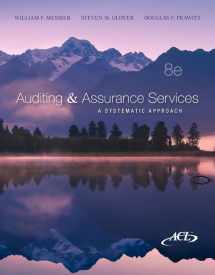
Auditing & Assurance Services: A Systematic Approach, 8th
Book details
Summary
Description
The authors believe students are best served by acquiring a strong understanding of the basic concepts that underlie the audit process and how to apply those concepts to various audit and assurance services. The primary purpose for an auditing text is not to serve as a reference manual but to facilitate student learning, and this text is written accordingly. The text is accessible to students through straightforward writing and the use of engaging, relevant real-world examples, illustrations, and analogies. The text explicitly encourages students to think through fundamental concepts and to avoid trying to learn auditing through rote memorization. Students are prompted by the text to “stop and think,” at important points in the text, in order to help them apply the principles covered.
The text continues to take a systematic approach to the audit process by first introducing the three underlying concepts: audit risk, materiality, and evidence. This is followed by a discussion of audit planning, the assessment of control risk, and a discussion of the nature, timing, and extent of evidence necessary to reach the appropriate level of detection risk. These concepts are then applied to each major business process and related account balances using a risk-based approach.
In covering these important concepts and their applications, the book focuses on critical judgments and decision-making processes followed by auditors. Much of auditing practice involves the application of auditor judgment. If a student understands these basic concepts and how to apply them to an audit engagement, he or she will be more effective in today’s dynamic audit environment.


We would LOVE it if you could help us and other readers by reviewing the book
Book review




